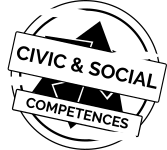Rights and Responsibilities of Citizenship: True or False
There are 10 cups stack to the wall. Each has a paper with a one written sentence about what citizen’s right or responsibility is. Groups of 3–4 people walk around and stop near each cup to discuss the sentences, they have to decide, whether the fact is true or false. Then every person votes individually. After that the votes are counted, and now the whole group has a discussion.
Anywhere
15-20
30 min
Target group
- Children (cca. 3 – 8 years)
- Older Kids (cca. 6 – 12 years)
- Teenagers (cca. 13 – 18 years)
- Young adults (cca. 17 – 26 years)
- NEETs
- Youth with fewer opportunities
- Youth workers
- Teachers

Content
The activity helps get to know civic rights and responsibilities, understand the benefits of knowing your rights and responsibilities for each individual and for a whole community. People learn to see and identify the problems in their community.
The method can be used also for other content.
Materials
Plastic cups, duct tape, paper, scissors, markersSpecific Environment
Specific goals
Knowledge of civil right and responsibilities; Communicating in a group; Critical thinking, as people discuss each paper together but vote individually; In a discussion participants are introduced to some practical advice; Discussion after the game is the space where people are encouraged to look deeper into the subject discovering and identifying positive aspects and challengesDescription
- 10 cups are stack to the wall. Each has a paper with a one written sentence about what citizen’s right or responsibility is.
- Groups of 3–4 people walk around and stop near each cup to discuss the sentences. They try to decide, whether the fact is true or false.
- Then every person votes individually on a piece of paper (t/f), and puts their votes into a cup.
- The votes are counted.
- The group and a leader sit in a circle and take one written sentence at a time and discuss it.
- Reflexion
Outcomes and its measurability
- Knowledge and understanding of the civic rights and responsibilities (participants feeling that they have learned about the subject at least 1 new thing)
- Expression (everybody votes and shares their thoughts in the group)
- Critical thinking (participants use versatile thinking then talking on a subject)
Project in which the method has been used
Title
Vilnius University non-formal education course



